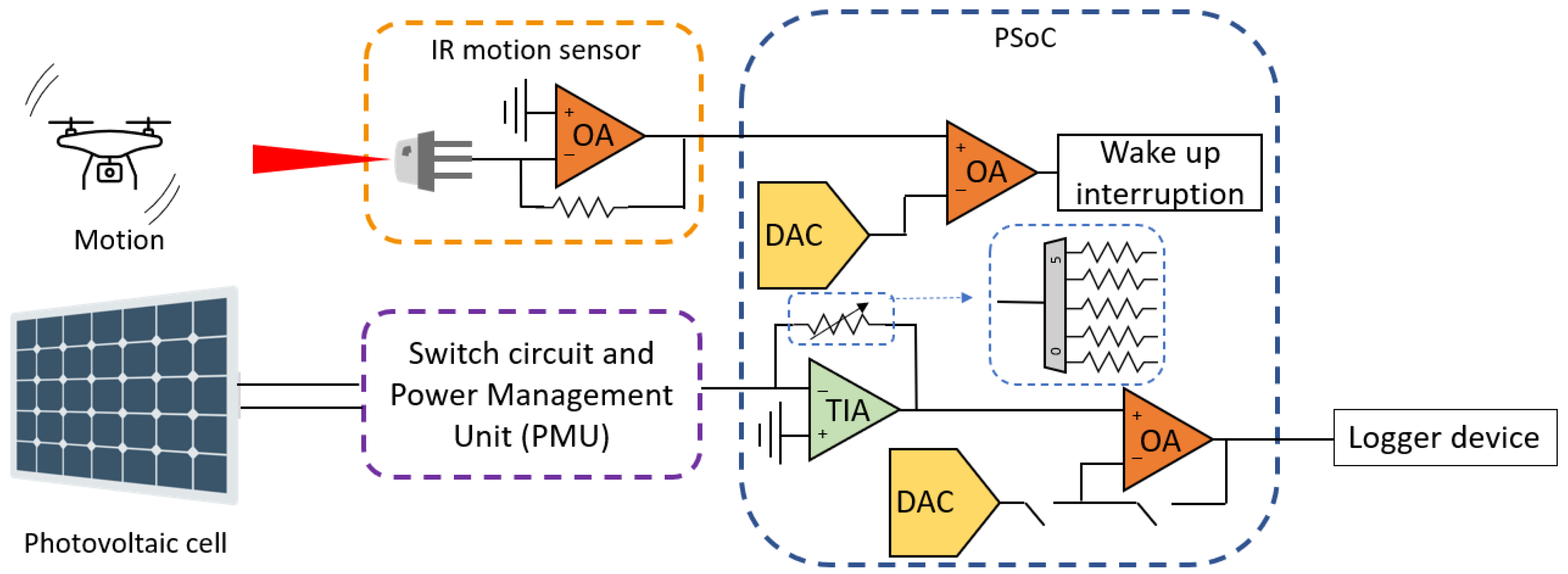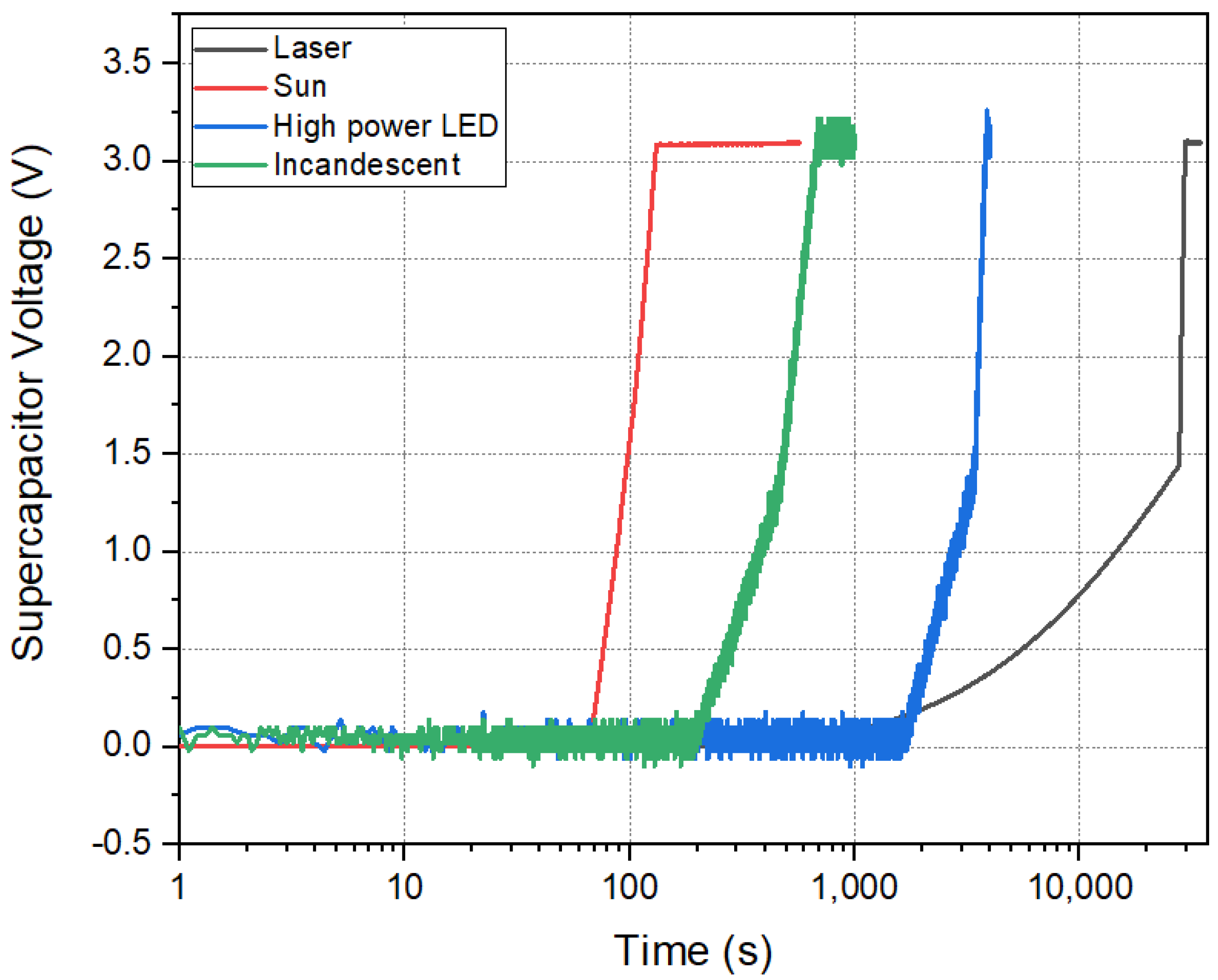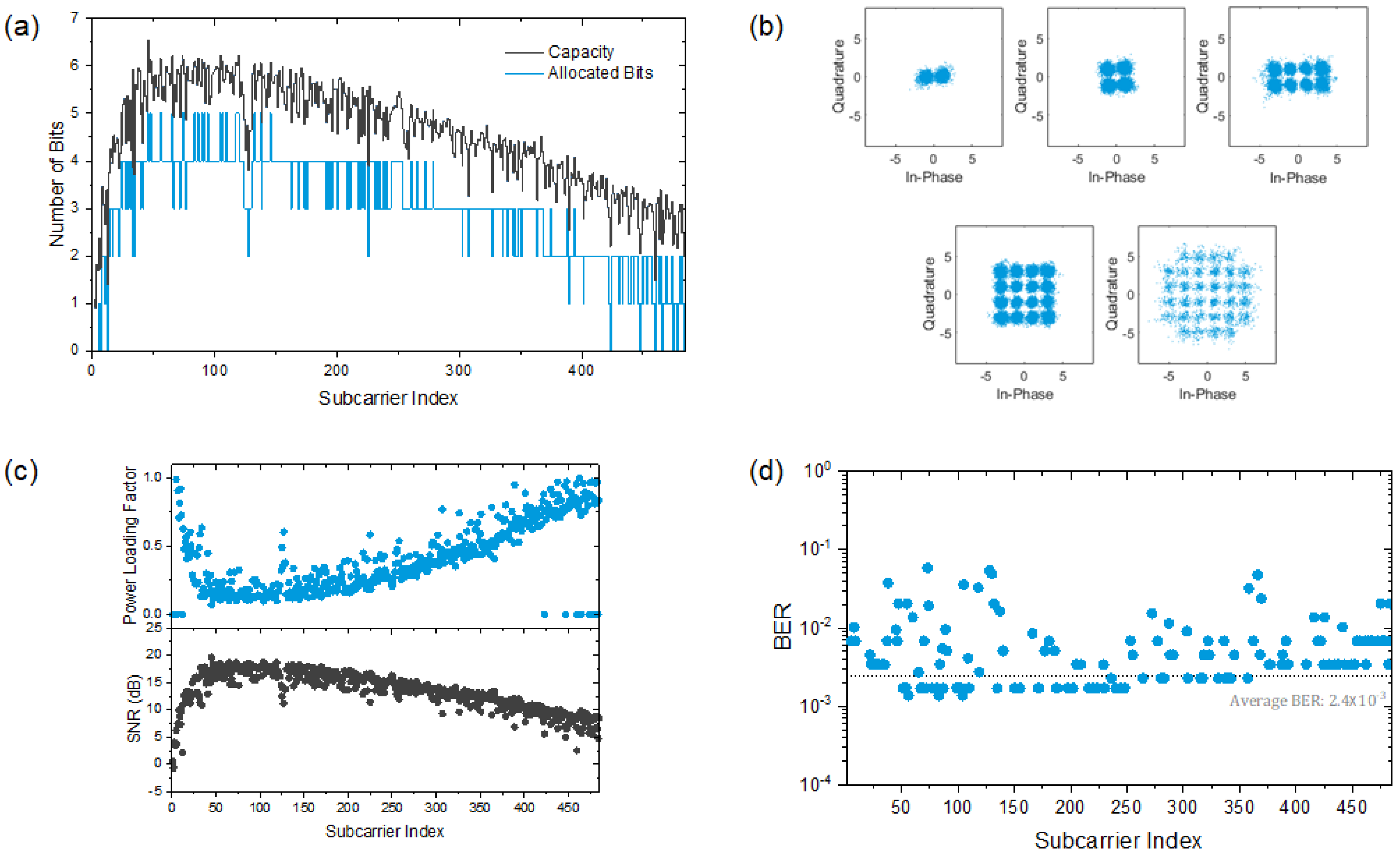Simultaneous Lightwave and Power Transfer for Internet of Things Devices
Abstract
:1. Introduction
2. Background
3. System Design and Experimental Methodology
3.1. Energy Harvesting
3.2. Information Decoding Capability
3.3. Detecting UAV Movements
4. Discussion
4.1. Active Area vs. Data Rate
4.2. Novel SC Materials for Higher Efficiency
5. Conclusions
Author Contributions
Funding
Data Availability Statement
Conflicts of Interest
Abbreviations
| AC | Alternating Current |
| ADC | Analog-to-Digital Converter |
| AWG | Arbitrary Waveform Generator |
| DC | Direct Current |
| EH | Energy Harvesting |
| FEC | Forward Error Correction |
| FSO | Free Space Optics |
| GaAs | Gallium Arsenide |
| ID | Information Decoding |
| IoT | Internet of Things |
| IoUT | Internet of Underwater Things |
| LD | Laser Diode |
| LED | Light Emitting Diode |
| LoS | Line of Sight |
| MPPT | Maximum Power Point Tracking |
| OFDM | Orthogonal Frequency Division Multiplexing |
| OOK | On-Off Keying |
| OA | Operational Amplifier |
| OWC | Optical Wireless Communication |
| PRBS | Pseudo-random Binary Sequence |
| PSoC | Programmable System on Chip |
| QAM | Quadrature Amplitude Modulation |
| RF | Radio Frequency |
| SC | Solar Cell |
| SLIPT | Simultaneous Lightwave and Information Transfer |
| SP | Solar Panel |
| SWIPT | Simultaneous Wireless Information and Power Transfer |
| TIA | Transimpedance Amplifier |
| UAV | Unmanned Aerial Vehicle |
| UWOC | Underwater Wireless Optical Communication |
| VLC | Visible Light Communication |
References
- Ponnimbaduge Perera, T.D.; Jayakody, D.N.K.; Sharma, S.K.; Chatzinotas, S.; Li, J. Simultaneous wireless information and power transfer (SWIPT): Recent advances and future challenges. IEEE Commun. Surv. Tutor. 2018, 20, 264–302. [Google Scholar] [CrossRef] [Green Version]
- Lu, X.; Wang, P.; Niyato, D.; Kim, D.I.; Han, Z. Wireless charging technologies: Fundamentals, standards, and network applications. IEEE Commun. Surv. Tutor. 2016, 18, 1413–1452. [Google Scholar] [CrossRef] [Green Version]
- Chiaraviglio, L.; Elzanaty, A.; Alouini, M.S. Health risks associated with 5G exposure: A view from the communications engineering perspective. IEEE Open J. Commun. Soc. 2021, 2, 2131–2179. [Google Scholar] [CrossRef]
- Kim, S.M.; Won, J.S. Simultaneous reception of visible light communication and optical energy using a solar cell receiver. In Proceedings of the 2013 International Conference on ICT Convergence (ICTC), Jeju Island, Korea, 14–16 October 2013; pp. 896–897. [Google Scholar]
- Wang, Z.; Tsonev, D.; Videv, S.; Haas, H. On the design of a solar-panel receiver for optical wireless communications with simultaneous energy harvesting. IEEE J. Sel. Areas Commun. 2015, 33, 1612–1623. [Google Scholar] [CrossRef]
- Zhang, S.; Tsonev, D.; Videv, S.; Ghosh, S.; Turnbull, G.A.; Samuel, I.D.W.; Haas, H. Organic solar cells as high-speed data detectors for visible light communication. Optica 2015, 2, 607–610. [Google Scholar] [CrossRef] [Green Version]
- Fakidis, J.; Videv, S.; Helmers, H.; Haas, H. 0.5-Gb/s OFDM-based laser data and power transfer using a GaAs photovoltaic cell. IEEE Photonics Technol. Lett. 2018, 30, 841–844. [Google Scholar] [CrossRef] [Green Version]
- Fakidis, J.; Helmers, H.; Haas, H. Trade-Off between energy harvesting and data communication towards a 1 Gb/s laser and photovoltaic link. In Proceedings of the Optical Wireless Fiber Power Transmission Conference, Yokohama, Japan, 21–23 April 2020; pp. 1–3. [Google Scholar]
- Fakidis, J.; Helmers, H.; Haas, H. Simultaneous wireless data and power transfer for a 1-Gb/s GaAs VCSEL and photovoltaic link. IEEE Photonics Technol. Lett. 2020, 32, 1277–1280. [Google Scholar] [CrossRef]
- Mica, N.A.; Bian, R.; Manousiadis, P.; Jagadamma, L.K.; Tavakkolnia, I.; Haas, H.; Turnbull, G.A.; Samuel, I.D.W. Triple-cation perovskite solar cells for visible light communications. Photonics Res. 2020, 8, A16–A24. [Google Scholar] [CrossRef]
- de Oliveira Filho, J.I.; Trichili, A.; Ooi, B.S.; Alouini, M.S.; Salama, K.N. Toward self-Powered internet of underwater things devices. IEEE Commun. Mag. 2020, 58, 68–73. [Google Scholar] [CrossRef]
- Uysal, M.; Ghasvarianjahromi, S.; Karbalayghareh, M.; Diamantoulakis, P.D.; Karagiannidis, G.K.; Sait, S.M. SLIPT for underwater visible light communications: Performance analysis and optimization. IEEE Trans. Wirel. Commun. 2021, 20, 6715–6728. [Google Scholar] [CrossRef]
- Haas, H.; Videv, S.; Das, S.; Fakidis, J.; Stewart, H. Solar cell receiver free-space optical for 5G backhaul. In Proceedings of the 2019 Optical Fiber Communications Conference and Exhibition (OFC), San Diego, CA, USA, 3–7 March 2019; pp. 1–3. [Google Scholar]
- Das, S.; Poves, E.; Fakidis, J.; Sparks, A.; Videv, S.; Haas, H. Towards energy neutral wireless communications: Photovoltaic cells to connect remote areas. Energies 2019, 12, 3772. [Google Scholar] [CrossRef] [Green Version]
- Filho, J.I.D.O.; Trichili, A.; Ooi, B.S.; Alouini, M.S.; Salama, K.N. Self-powered weather station for remote areas and difficult-access locations. Opt. Express 2022, 30, 2668–2679. [Google Scholar] [CrossRef]
- What Is Maximum Power Point Tracking MPPT. Available online: https://www.solar-electric.com/learning-center/mppt-solar-charge-controllers.html/ (accessed on 18 April 2021).
- Adamo, F.; Attivissimo, F.; Di Nisio, A.; Spadavecchia, M. Characterization and testing of a tool for photovoltaic panel modeling. IEEE Trans. Instrum. Meas. 2011, 60, 1613–1622. [Google Scholar] [CrossRef]
- Trichili, A.; Cox, M.A.; Ooi, B.S.; Alouini, M.S. Roadmap to free space optics. J. Opt. Soc. Am. B 2020, 37, A184–A201. [Google Scholar] [CrossRef]
- Kong, M.; Sun, B.; Sarwar, R.; Shen, J.; Chen, Y.; Qu, F.; Han, J.; Chen, J.; Qin, H.; Xu, J. Underwater wireless optical communication using a lens-free solar panel receiver. Opt. Commun. 2018, 426, 94–98. [Google Scholar] [CrossRef]
- Alkhazragi, O.; Trichili, A.; Ashry, I.; Ng, T.K.; Alouini, M.S.; Ooi, B.S. Wide-field-of-view optical detectors using fused fiber-optic tapers. Opt. Lett. 2021, 46, 1916–1919. [Google Scholar] [CrossRef] [PubMed]
- Sciuto, G.L.; Capizzi, G.; Coco, S.; Shikler, R. Geometric shape optimization of organic solar cells for efficiency enhancement by neural networks. In Advances on Mechanics, Design Engineering and Manufacturing; Springer: Berlin/Heidelberg, Germany, 2017; pp. 789–796. [Google Scholar]








| Approach | Time Switching | Power Splitting | Space Splitting |
|---|---|---|---|
| Hardware Complexity | Low | High | Moderate |
| Real-Time EH and ID | No | Yes | Yes |
| MPPT | Yes | No | Yes |
| Cost | Low | Moderate | High |
| Distance (m) | Gross Data Rate (Mbps) | Net Data Rate (Mbps) |
|---|---|---|
| 2 | 1.4 | 1.3 |
| 10 | 1.05 | 0.95 |
| 20 | 0.87 | 0.79 |
| Reference | SC Technology | Active Area (mm) | Max Data Rate (Mbps) |
|---|---|---|---|
| [5] | Multi-crystalline Si | 43,200 | 11.84 (OFDM) |
| [6] | Organic (PTB7:PCBM) | 8 | 34.2 (OFDM) |
| [9] | GaAs | 0.8 | 1000 (OFDM) |
| [10] | Triple-cation perovskite | 6.5 | 56 (OFDM) |
| This work | Mono-crystalline Si | 3850 | 1.4 (OFDM) |
Publisher’s Note: MDPI stays neutral with regard to jurisdictional claims in published maps and institutional affiliations. |
© 2022 by the authors. Licensee MDPI, Basel, Switzerland. This article is an open access article distributed under the terms and conditions of the Creative Commons Attribution (CC BY) license (https://creativecommons.org/licenses/by/4.0/).
Share and Cite
Filho, J.I.D.O.; Alkhazragi, O.; Trichili, A.; Ooi, B.S.; Alouini, M.-S.; Salama, K.N. Simultaneous Lightwave and Power Transfer for Internet of Things Devices. Energies 2022, 15, 2814. https://doi.org/10.3390/en15082814
Filho JIDO, Alkhazragi O, Trichili A, Ooi BS, Alouini M-S, Salama KN. Simultaneous Lightwave and Power Transfer for Internet of Things Devices. Energies. 2022; 15(8):2814. https://doi.org/10.3390/en15082814
Chicago/Turabian StyleFilho, José Ilton De Oliveira, Omar Alkhazragi, Abderrahmen Trichili, Boon S. Ooi, Mohamed-Slim Alouini, and Khaled Nabil Salama. 2022. "Simultaneous Lightwave and Power Transfer for Internet of Things Devices" Energies 15, no. 8: 2814. https://doi.org/10.3390/en15082814
APA StyleFilho, J. I. D. O., Alkhazragi, O., Trichili, A., Ooi, B. S., Alouini, M.-S., & Salama, K. N. (2022). Simultaneous Lightwave and Power Transfer for Internet of Things Devices. Energies, 15(8), 2814. https://doi.org/10.3390/en15082814







